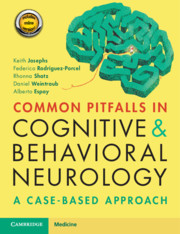Book contents
- Common Pitfalls in Cognitive and Behavioral Neurology
- Common Pitfalls in Cognitive and Behavioral Neurology
- Copyright page
- Dedication
- Contents
- Diseases Discussed in the Book
- Preface
- Acknowledgements
- Abbreviations
- Part 1 Missing the Diagnosis Altogether
- Part 2 Misidentifying the Impaired Cognitive Domain
- Part 3 Missing Important Clues in the History
- Case 11 The Stroke of Clarity
- Case 12 Losing One’s Mind without Knowing?
- Case 13 The Disease Has Caught Up with Her
- Case 14 Recognizing the Right Signs of Memory Impairment
- Case 15 Talking about Family Matters
- Part 4 Failure of Pattern Recognition
- Part 5 Difficult-to-Characterize Cognitive/Behavioral Disorders
- Part 6 Clinical Findings That Are Subtle
- Part 7 Misinterpreting Test Results
- Part 8 Attributing Findings to a Known or Suspected Disorder
- Part 9 Missing Radiographic Clues
- Part 10 Management Misadventures
- Index
- Plate Section (PDF Only)
- References
Case 13 - The Disease Has Caught Up with Her
from Part 3 - Missing Important Clues in the History
Published online by Cambridge University Press: 03 November 2020
- Common Pitfalls in Cognitive and Behavioral Neurology
- Common Pitfalls in Cognitive and Behavioral Neurology
- Copyright page
- Dedication
- Contents
- Diseases Discussed in the Book
- Preface
- Acknowledgements
- Abbreviations
- Part 1 Missing the Diagnosis Altogether
- Part 2 Misidentifying the Impaired Cognitive Domain
- Part 3 Missing Important Clues in the History
- Case 11 The Stroke of Clarity
- Case 12 Losing One’s Mind without Knowing?
- Case 13 The Disease Has Caught Up with Her
- Case 14 Recognizing the Right Signs of Memory Impairment
- Case 15 Talking about Family Matters
- Part 4 Failure of Pattern Recognition
- Part 5 Difficult-to-Characterize Cognitive/Behavioral Disorders
- Part 6 Clinical Findings That Are Subtle
- Part 7 Misinterpreting Test Results
- Part 8 Attributing Findings to a Known or Suspected Disorder
- Part 9 Missing Radiographic Clues
- Part 10 Management Misadventures
- Index
- Plate Section (PDF Only)
- References
Summary
This 75-year-old right-handed woman presented to the clinic for an urgent follow-up due to subacute changes in her speech. She had been diagnosed with Alzheimer disease two years prior, after presenting with a four-year history of progressive memory impairment. Her symptoms were stable until three weeks prior to her follow-up visit, when she became less talkative than usual and started slurring her speech. This was initially attributed to being tired (hectic holidays), but she continued to worsen, prompting an urgent visit to the primary care physician, who ruled out infections and metabolic abnormalities. She eventually plateaued, and the family considered the impaired communication her new baseline. Three days prior to the visit, she had a fall and hit her head. Since then, her speech further declined, and she was having difficulties with dexterity on the right. Although the family was aware she had previous falls, they stated this was the first time she had hit her head.
- Type
- Chapter
- Information
- Common Pitfalls in Cognitive and Behavioral NeurologyA Case-Based Approach, pp. 40 - 41Publisher: Cambridge University PressPrint publication year: 2020

